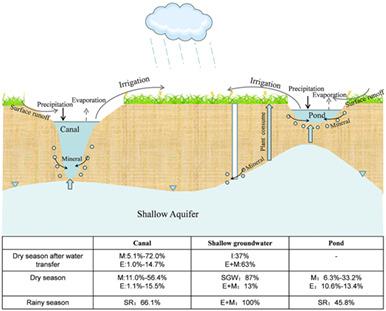当前位置:
X-MOL 学术
›
Hydrol. Process.
›
论文详情
Our official English website, www.x-mol.net, welcomes your
feedback! (Note: you will need to create a separate account there.)
Quantification of surface water and groundwater salinity sources in irrigated lowland area of North China Plain
Hydrological Processes ( IF 2.8 ) Pub Date : 2021-01-07 , DOI: 10.1002/hyp.14037 Xiaole Kong 1 , Shiqin Wang 1 , Yan‐Jun Shen 1 , Zhuping Sheng 2 , Xiaojing Liu 1 , Fei Ding 3
Hydrological Processes ( IF 2.8 ) Pub Date : 2021-01-07 , DOI: 10.1002/hyp.14037 Xiaole Kong 1 , Shiqin Wang 1 , Yan‐Jun Shen 1 , Zhuping Sheng 2 , Xiaojing Liu 1 , Fei Ding 3
Affiliation

|
Seasonally variation of water salinity is observed worldwide, the mechanisms of water salinity are not well understood due to natural factors and anthropogenic activities. Quantification water salinity source are challenging since complex influence factors, especially in agricultural regions irrigated with multi‐water sources. In the lowland area of North China Plain, transferred water, brackish shallow groundwater and fresh deep groundwater were combinative utilized to relieve prominent contradictions between regional water shortages and grain production. In this study, influence factors of surface water (canal water, pond water) and shallow groundwater salinity were identified and quantified through statistical analysis, deuterium excess, and ionic relationship. Salinity of canal water and pond water increased in dry season and decreased in rainy season, while salinity of shallow groundwater decreased in dry season after water transfer and rainy season, but increased in dry season. Evaporation and mineral dissolution were main factors for surface water salinity in dry season, with mineral dissolution was the more important one. The contribution ratio of evaporation and mineral dissolution for canal salinity were 4.4 and 49.1% in dry season after water transfer, 7.1 and 34.4% in dry season, and that for pond water salinity were 12.4 and 18.3% in dry season, respectively. Precipitation and surface runoff were main factors for surface water salinity in rainy season. The contribution of surface runoff for canal water and pond water salinity were 66.1 and 45.8%, respectively. Salinity of canal water and shallow groundwater was temporary decreased by water transfer. Domestic sewage from rural areas had larger influence than agricultural activities for salinity increase of pond water and shallow groundwater. Mineral dissolution was the main contributor for shallow groundwater salinity, with contribution ratio larger than 60% in different periods. This study demonstrated and quantified salinity source of surface water and shallow groundwater and may deepen our understanding of water management under multi‐water resources utilization.
中文翻译:

华北平原灌溉低地地区地表水和地下水盐分源的定量分析
全世界都观察到水盐度的季节性变化,由于自然因素和人为活动,人们对水盐度的机理还没有很好的了解。由于复杂的影响因素,尤其是在使用多水源灌溉的农业地区,量化水盐度源具有挑战性。在华北平原低地地区,结合利用调水,微咸浅层地下水和新鲜深层地下水,缓解了区域缺水与粮食生产之间的突出矛盾。在这项研究中,通过统计分析,氘过量和离子关系确定并量化了地表水(运河水,池塘水)和浅层地下水盐度的影响因素。旱季运河水和池塘水的盐度增加,而在雨季有所减少,而调水和雨季后的旱季,浅层地下水的盐度减少,但在旱季增加。蒸发和矿物质溶解是干旱季节地表水盐度的主要因素,其中矿物质溶解是最重要的因素。调水后旱季盐分蒸发和矿物质溶解的贡献率分别为4.4%和49.1%,旱季为7.1%和34.4%,池塘水盐分的贡献度分别为旱季的12.4%和18.3%。降水和地表径流是雨季地表水盐度的主要因素。地表径流对运河水和池塘水盐分的贡献分别为66.1%和45.8%。通过调水,运河水和浅层地下水的盐度暂时降低。农村地区的生活污水对池塘水和浅层地下水的盐分增加的影响大于农业活动。矿物溶解是浅层地下水盐度的主要贡献者,不同时期贡献率大于60%。这项研究证明并量化了地表水和浅层地下水的盐分来源,并可能加深我们对多种水资源利用下的水资源管理的理解。在不同时期的贡献率大于60%。这项研究证明并量化了地表水和浅层地下水的盐分来源,并可能加深我们对多种水资源利用下的水资源管理的理解。在不同时期的贡献率大于60%。这项研究证明并量化了地表水和浅层地下水的盐分来源,并可能加深我们对多种水资源利用下的水资源管理的理解。
更新日期:2021-01-07
中文翻译:

华北平原灌溉低地地区地表水和地下水盐分源的定量分析
全世界都观察到水盐度的季节性变化,由于自然因素和人为活动,人们对水盐度的机理还没有很好的了解。由于复杂的影响因素,尤其是在使用多水源灌溉的农业地区,量化水盐度源具有挑战性。在华北平原低地地区,结合利用调水,微咸浅层地下水和新鲜深层地下水,缓解了区域缺水与粮食生产之间的突出矛盾。在这项研究中,通过统计分析,氘过量和离子关系确定并量化了地表水(运河水,池塘水)和浅层地下水盐度的影响因素。旱季运河水和池塘水的盐度增加,而在雨季有所减少,而调水和雨季后的旱季,浅层地下水的盐度减少,但在旱季增加。蒸发和矿物质溶解是干旱季节地表水盐度的主要因素,其中矿物质溶解是最重要的因素。调水后旱季盐分蒸发和矿物质溶解的贡献率分别为4.4%和49.1%,旱季为7.1%和34.4%,池塘水盐分的贡献度分别为旱季的12.4%和18.3%。降水和地表径流是雨季地表水盐度的主要因素。地表径流对运河水和池塘水盐分的贡献分别为66.1%和45.8%。通过调水,运河水和浅层地下水的盐度暂时降低。农村地区的生活污水对池塘水和浅层地下水的盐分增加的影响大于农业活动。矿物溶解是浅层地下水盐度的主要贡献者,不同时期贡献率大于60%。这项研究证明并量化了地表水和浅层地下水的盐分来源,并可能加深我们对多种水资源利用下的水资源管理的理解。在不同时期的贡献率大于60%。这项研究证明并量化了地表水和浅层地下水的盐分来源,并可能加深我们对多种水资源利用下的水资源管理的理解。在不同时期的贡献率大于60%。这项研究证明并量化了地表水和浅层地下水的盐分来源,并可能加深我们对多种水资源利用下的水资源管理的理解。











































 京公网安备 11010802027423号
京公网安备 11010802027423号